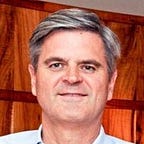Learnings from the Road
When we first sat down to select the cities for the sixth Rise of the Rest tour, our nation had just elected a new president and a new conversation about the future of two Americas, one on the coasts and one in the middle of the country, was taking hold. We selected the cities for our tour — Central Pennsylvania (York, Lancaster, Harrisburg); Ann Arbor, MI; Indianapolis, IN; Columbus, OH; and Green Bay, WI — in part, because we knew each of these states was facing significant challenges. But we also knew that the innovation ecosystems in each of these cities was an example of the power of startups to transform economies.
Over the last week and a half, Revolution, including our newest partner, Hillbilly Elegy author and investor, JD Vance, relished the opportunity to learn more about what makes each of these cities successful in the face of changing demographic and economic dynamics. We experienced the startup renaissance first hand, touring businesses at different stages, incubators, and co-working spaces. We visited with entrepreneurs and ecosystem builders. We learned from university and government leaders. And although we had been to 26 cities prior, I think we all walked away with new knowledge and a more nuanced perspective of what needs to happen to make the innovation hubs of the future.
First, network density. It’s something we talk about often on our Rise of the Rest tours. Silicon Valley clearly has it. New York and Boston do as well. In those cities, you can’t turn the corner without running into someone who could potentially help you with a customer, a coder, a mentor or investor. That has not always been the case in other cities across the country. But that’s changing. I thought a lot about network density as we set off on our sixth Rise of the Rest tour last week. Each city on our tour was tackling the issue in its own way, proving once again that innovation economies are most successful when they capitalize on their unique strengths. In Central Pennsylvania and Green Bay, Wisconsin, they strengthened their network by creating an innovation region with greater resources than one city could provide. In Ann Arbor, they leveraged the extraordinary resources of a world-class university. In Indianapolis, they drew on the success of a high profile exit with founders that doubled down on the community. And in Columbus, the wealth of forward thinking traditional companies has led to an ecosystem with a strong talent pipeline and opportunities for collaboration.
Next, a talent boomerang. Many of the communities experienced a brain drain over the last decade as young people felt they needed to leave to pursue opportunity. That drain is slowing with people returning to their hometowns or places they went to college. They not only want a more moderate cost of living, but they are drawn to rebuilding a city that means something to them. A perfect example is the founder and CEO of FarmLogs, a provider of farm management software. He built FarmLogs in Silicon Valley, but moved to Ann Arbor to be closer to his customers and his family of farmers.
And third, tent pole companies play a key role in providing validation to investors, momentum for the community, and mentorship to startups. Exact Target in Indianapolis was acquired by Salesforce for $2.5B a few years ago. Instead of closing up shop, Salesforce doubled down on Indianapolis (where it now has 2,000 employees and its second largest location in the world) creating jobs and attracting talent. And the founders have committed to the Indy tech scene as well. Scott Dorsey used his success to start High Alpha, a venture studio to help fund ideas and entrepreneurs. Chris Baggott, also an Exact Target founder, created another Indy-based startup with the food delivery company, ClusterTruck. The success of one company can have a ripple effect for the entire community.
We end each day on tour with a pitch competition, where local entrepreneurs vie for a $100,000 investment. I was pleasantly surprised at the strength of the pitches. Many of the judges’ deliberations had robust discussions on who had the best team, the best idea, and the best execution to garner an investment. In the end, I’m delighted to welcome these five to the Rise of the Rest portfolio:
Central PA: Device Events
Device Events develops software that identifies patterns of problems with medical devices to improve patient safety and reduce risk.
Ann Arbor: SAHI Cosmetics
SAHI Cosmetics provides custom makeup for women of ethnic skin tones, specifically medium skin tones.
Indianapolis: 120WaterAudit
120WaterAudit provides an online platform that manages water quality compliance.
Columbus: SafeChain
SafeChain eliminates fraud and inefficiency in real estate transactions using blockchain.
Green Bay: lanehub
Lanehub is the social network for transportation — freight lane matching and collaboration.
Each city has a different story driven by the incredible enthusiasm of the startup community. I hope we have done our part by bringing these stories to more people in more places.
